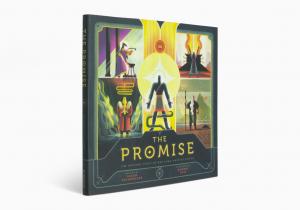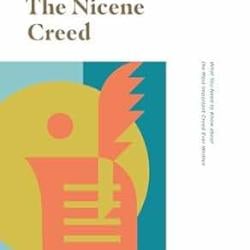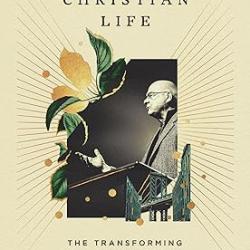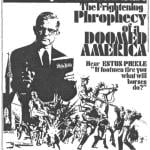In terms of the books that are available, we’re living in a golden age for parents of small children. Christian publishers are cranking out high-quality books at a record rate (and that’s without getting into the self-published stuff). It seems that high-quality materials are being published daily. However, in the rush to get books into children’s hands (that of course is the non-cynical way to say it), I am a little concerned that corners are beginning to be cut and the quality of the work is starting to slip.
Or maybe I’m overreacting to the latest of these books I’ve read, Jason Helopoulos’s and Rommel Ruiz’s The Promise: The Amazing Story of our long-awaited Savior.

Before talking about some of the problems with this book, first: the strengths.
I’ve said before on here that I’m no judge of the quality of art, but the art of The Promise looks pretty solid to me. It is creative and matches the themes, mood, and tone of the text well. In other words, the art appears to be excellent to my untrained/inexpert eye.
Likewise The Promise provides an excellent overview of the first three chapters of Genesis, and a solid Biblical theology (in children’s form, of course) of the Old Testament and how it points to Christ.
And as with most of these books, there’s nothing inappropriate or unorthodox in the book. It is fine to read to children and will undoubtedly make an excellent addition to most children’s bookshelves (the problems I’m going to mention momentarily aren’t the sort that will be noticed by or matter to kids).
And yet, there are a couple of big issues here.
The first issue is editing. Or at least, I assume it’s a problem of editing–I’ve never published a book, so maybe I’m blaming the wrong folks. Specifically the pacing and order of the book are… awkward. The first third of the book covers the first three chapters of Genesis. The middle half of the book covers the stretch of Scripture from Noah to the temple sacrifice. The last sixth of the book is about Jesus. I get that in a children’s book you’re not going to spend a lot of time on, say, the minor prophets. But that’s still an odd pace to set.
The order is also a little odd, particularly in the half of the book covering the time from Noah to the temple. In this section, The Promise walks through major Biblical figures and explains why they are not the fulfillment of God’s promise of deliverance in Genesis 3 (so, Noah was a good man, but still sinned; Saul was a king, but was proud, etc). It also highlights the fact that obedience to the Law won’t save us, either in terms of doing good or in terms of making the sacrifice to pay for the times we have disobeyed. I assume that the order here is topical(i.e. Patriarch-Abraham, Lawgiver-Moses… ‘man after God’s own heart’-David, Priest-Eli). But it also puts things in an odd order, where David is discussed before Eli, and the kings of Israel are discussed before the law. Again, this won’t matter to children, but it’s a bit jarring otherwise.
The second issue, and I think the bigger one here, is that there is no Gospel in this book. Yes, Jesus is held up as the one who fulfills ‘the promise of God’:
“In this child, the promise came.
He was the one who would crush the head of the serpent,
deliver mankind from their sin, grant them his righteousness,
work in them his holiness, give them his life.
But best of all… he secured his people’s relationship with God.
Once again, people could be with God. Forever, God would be their friend.
There has never been and never shall be a Savior like this.” (np)
Then the book connects Jesus to the previous pages, saying that He succeeds as the “perfect Prophet of God…the perfect Judge… the perfect Sacrifice” etc (np) Ultimately on the last page [so, spoiler alert, I guess], we are told that “Jesus was and is the promised one, the perfect one, the one who would not and could not sin, the one great Savior of men and women.” (last page).
All of this is certainly true, but at no point are we told how the Promised One does this. Jesus was in fact the “one who would not and could not sin”, but so what? What good does that do for you or me? He was the “perfect Sacrifice”, but what does that mean for us? How is that relevant? We’re asked on the last page whether we “know this promised one?” or whether we have “trusted in him so that you are friends with God?”, but again how? We are not told the heart of the Gospel, the great truth that Jesus didn’t just die sinless, He didn’t just live perfectly, He did those things in our place. It’s not just that everyone before Him in the Old Testament failed and He succeeded, it’s that He succeeded for us, as our substitute. Jesus fulfills the promise of God and reconciles us to God by his atoning sacrifice on the cross. It was His penal substitution that makes everything promised in the Old Testament available to those of us who embrace by faith alone these promises.
And no, I obviously don’t expect a children’s book to get into the systematic mechanics of atonement. Yet, in a book that claims to explain ‘the promise’ of God that’s a key, no… that’s the key part of the promise, and to leave it out greatly lessens the value of what is otherwise a well done book. (The more cynical part of me wonders whether this wasn’t yet another editorial decision to keep the book marketable to those who claim to be Christian and yet reject penal substitution as “divine child abuse.”)
So, like I said, The Promise kind of a mixed bag. There’s certainly a lot good about this book, but there are a lot of ways in which it could have used a bit more working out by the authors (or editors or whoever).
Dr. Coyle Neal is co-host of the City of Man Podcast and an Associate Professor of Political Science at Southwest Baptist University in Bolivar, MO












